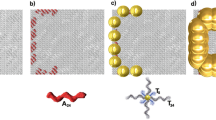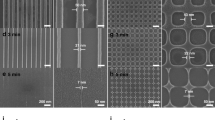Abstract
Nanowire fabrication methods can be classified either as ‘top down’, involving photo- or electron-beam lithography, or ‘bottom up’, involving the synthesis of nanowires from molecular precursors. Lithographically patterned nanowire electrodeposition (LPNE) combines attributes of photolithography with the versatility of bottom-up electrochemical synthesis. Photolithography defines the position of a sacrificial nickel nanoband electrode, which is recessed into a horizontal trench. This trench acts as a ‘nanoform’ to define the thickness of an incipient nanowire during its electrodeposition. The electrodeposition duration determines the width of the nanowire. Removal of the photoresist and nickel exposes a polycrystalline nanowire — composed of gold, platinum or palladium — characterized by thickness and width that can be independently controlled down to 18 and 40 nm, respectively. Metal nanowires prepared by LPNE may have applications in chemical sensing and optical signal processing, and as interconnects in nanoelectronic devices.
This is a preview of subscription content, access via your institution
Access options
Subscribe to this journal
Receive 12 print issues and online access
$259.00 per year
only $21.58 per issue
Buy this article
- Purchase on Springer Link
- Instant access to full article PDF
Prices may be subject to local taxes which are calculated during checkout






Similar content being viewed by others
References
Spicer, D. F., Rodger, A. C. & Varnell, G. L. Computer-controlled pattern generating system for use with electron-beam writing instruments. J. Vac. Sci. Technol. 10, 1052–1055 (1973).
Varnell, G. L., Spicer, D. F. & Rodger, A. C. E-Beam writing techniques for semiconductor-device fabrication. J. Vac. Sci. Technol. 10, 1048–1051 (1973).
Vieu, C. et al. Electron beam lithography: Resolution limits and applications. Appl. Surf. Sci. 164, 111–117 (2000).
Berger, S. D. & Gibson, J. M. New approach to projection-electron lithography with demonstrated 0.1 μM linewidth. Appl. Phys. Lett. 57, 153–155 (1990).
Berger, S. D. et al. Projection electron-beam lithography—A new approach. J. Vac. Sci. Technol. B 9, 2996–2999 (1991).
Liddle, J. A. et al. Space-charge effects in projection electron-beam lithography: Results from the SCALPEL proof-of-lithography system. J. Vac. Sci. Technol. B 19, 476–481 (2001).
Jorritsma, J., Gijs, M. A. M., Kerkhof, J. M. & Stienen, J. G. H. General technique for fabricating large arrays of nanowires. Nanotechnology 7, 263–265 (1996).
Natelson, D., Willett, R. L., West, K. W. & Pfeiffer, L. N. Fabrication of extremely narrow metal wires. Appl. Phys. Lett. 77, 1991–1993 (2000).
Natelson, D., Willett, R. L., West, K. W. & Pfeiffer, L. N. Geometry-dependent dephasing in small metallic wires. Phys. Rev. Lett. 86, 1821–1824 (2001).
Melosh, N. A. et al. Ultrahigh-density nanowire lattices and circuits. Science 300, 112–115 (2003).
Thompson, M. A., Menke, E. J., Martens, C. C. & Penner, R. M. Shrinking nanowires by kinetically controlled electrooxidation. J. Phys. Chem. B 110, 36–41 (2006).
Nagale, M. P. & Fritsch, I. Individually addressable, submicrometer band electrode arrays. 1. Fabrication from multilayered materials. Anal. Chem. 70, 2902–2907 (1998).
Bard, A. J. Electrochemical Methods: Fundamentals and Applications (Wiley, New York, 2001).
Walter, E. C. et al. Noble and coinage metal nanowires by electrochemical step edge decoration. J. Phys. Chem. B 106, 11407–11411 (2002).
Durkan, C. & Welland, M. E. Size effects in the electrical resistivity of polycrystalline nanowires. Phys. Rev. B 61, 14215–14218 (2000).
Marzi, G. D., Iacopino, D., Quinn, A. J. & Redmond, G. Probing intrinsic transport properties of single metal nanowires: Direct-write contact formation using a focused ion beam. J. Appl. Phys. 96, 3458–3462 (2004).
Yang, F. Y. et al. Large magnetoresistance of electrodeposited single-crystal bismuth thin films. Science 284, 1335–1337 (1999).
Yang, F. Y. et al. Large magnetoresistance and finite-size effect in electrodeposited bismuth lines. J. Appl. Phys. 89, 7206–7208 (2001).
Chiu, P. & Shih, I. A study of the size effect on the temperature-dependent resistivity of bismuth nanowires with rectangular cross-sections. Nanotechnology 15, 1489–1492 (2004).
Fuchs, K. The conductivity of thin metallic films according to the electron theory of metals. Proc. Camb. Phil. Soc. 34, 100–108 (1938).
Sondheimer, E. H. The mean free path of electrons in metals. Adv. Phys. 1, 1–42 (1952).
Mayadas, A. F. & Shatzkes, M. Electrical-resistivity model for polycrystalline films—case of arbitrary reflection at external surfaces. Phys. Rev. B 1, 1382–1389 (1970).
Steinhogl, W., Schindler, G., Steinlesberger, G., Traving, M. & Engelhardt, M. Comprehensive study of the resistivity of copper wires with lateral dimensions of 100 nm and smaller. J. Appl. Phys. 97, 023706 (2005).
Marom, H. & Eizenberg, M. The temperature dependence of resistivity in thin metal films. J. Appl. Phys. 96, 3319–3323 (2004).
Steinhogl, W., Schindler, G., Steinlesberger, G. & Engelhardt, M. Size-dependent resistivity of metallic wires in the mesoscopic range. Phys. Rev. B 66, 075414 (2002).
Acknowledgements
The National Science Foundation funded this work through grant CHE-0111-557.
Author information
Authors and Affiliations
Corresponding author
Ethics declarations
Competing interests
The authors declare no competing financial interests.
Rights and permissions
About this article
Cite this article
Menke, E., Thompson, M., Xiang, C. et al. Lithographically patterned nanowire electrodeposition. Nature Mater 5, 914–919 (2006). https://doi.org/10.1038/nmat1759
Received:
Accepted:
Published:
Issue Date:
DOI: https://doi.org/10.1038/nmat1759
This article is cited by
-
A molecular dynamics study on the buckling behavior of single-walled carbon nanotubes filled with gold nanowires
Journal of Molecular Modeling (2020)
-
Plasmon hybridization engineering in self-organized anisotropic metasurfaces
Nano Research (2018)
-
Facile preparation of Ag–Ag2S hetero-dendrites with high visible light photocatalytic activity
Journal of Materials Science (2018)
-
Controlled Structure of Electrochemically Deposited Pd Nanowires in Ion-Track Templates
Nanoscale Research Letters (2015)
-
Over-limiting Current and Control of Dendritic Growth by Surface Conduction in Nanopores
Scientific Reports (2014)



